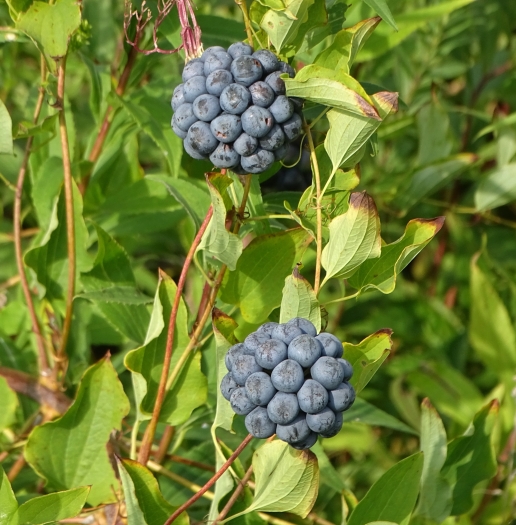Smooth Carrionflower
(Smilax herbacea)
Smooth Carrionflower (Smilax herbacea)
/
/

Shirley Zundell
CC BY 4.0
Image By:
Shirley Zundell
Recorded By:
Copyright:
CC BY 4.0
Copyright Notice:
Photo by: Shirley Zundell | License Type: CC BY 4.0 | License URL: http://creativecommons.org/licenses/by/4.0/ | Rights Holder: Shirley Zundell | Publisher: iNaturalist | Date Created: 2018-08-26T10:32:10-07:00 |
















Estimated Native Range
Summary
Smilax herbacea, commonly known as smooth carrionflower, is a deciduous vine native to the rich, moist deciduous forests and floodplain meadows of eastern Canada and the eastern United States. It can grow over 8 feet tall, with climbing stems that wrap around nearby supports. The plant features alternate, simple, heart-shaped leaves and produces small, greenish-yellow flowers in the spring, which are not particularly showy but have a distinctive odor that attracts pollinating flies. After flowering, it bears small, dark blue berries that are enjoyed by birds and other wildlife.
Smooth carrionflower is valued for its vigorous growth and its ability to cover trellises or fences, providing a lush green backdrop in gardens. It is also used in restoration projects for its ability to stabilize soil in riparian zones. In cultivation, it prefers partial to full shade, moist soil with good drainage, and requires minimal maintenance once established. While not commonly used in modern horticulture, its young shoots are edible and have been likened to asparagus. It is also noted in traditional Ainu medicine for various uses. Gardeners should be aware that the plant can spread aggressively through its rhizomes, potentially becoming invasive in some conditions.CC BY-SA 4.0
Smooth carrionflower is valued for its vigorous growth and its ability to cover trellises or fences, providing a lush green backdrop in gardens. It is also used in restoration projects for its ability to stabilize soil in riparian zones. In cultivation, it prefers partial to full shade, moist soil with good drainage, and requires minimal maintenance once established. While not commonly used in modern horticulture, its young shoots are edible and have been likened to asparagus. It is also noted in traditional Ainu medicine for various uses. Gardeners should be aware that the plant can spread aggressively through its rhizomes, potentially becoming invasive in some conditions.CC BY-SA 4.0
Plant Description
- Plant Type: Herb, Vine
- Height: 1-8 feet
- Width: 1-8 feet
- Growth Rate: Slow
- Flower Color: N/A
- Flowering Season: Spring, Summer
- Leaf Retention: Deciduous
Growth Requirements
- Sun: Full Sun, Part Shade
- Water: Medium
- Drainage: Fast, Medium, Slow
Common Uses
Bird Garden, Deer Resistant, Low Maintenance
Natural Habitat
Rich, moist deciduous forests and floodplain meadows
Other Names
Common Names: Smooth Carrionflower, Jacob’s Ladder, Herbaceous Greenbriar, Jacob’s Lader, Herbaceous Carrionflower, Herbaceous Greenbrier
Scientific Names: , Smilax herbacea, Coprosmanthus consanguineus, Coprosmanthus herbaceus, Coprosmanthus peduncularis, Nemexia cerulea, Nemexia herbacea, Nemexia nigra, Smilax herbacea subsp. crispifolia, Smilax herbacea var. herbacea
GBIF Accepted Name: